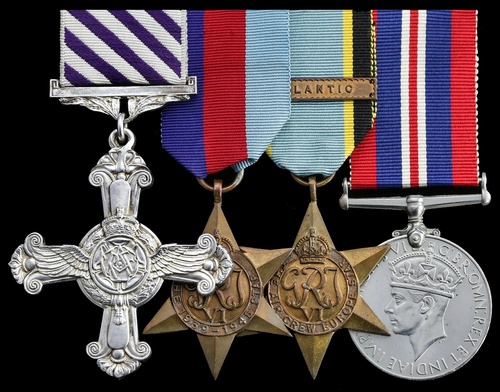
Auction: 18001 - Orders, Decorations and Medals
Lot: 22
An unusual Second World War D.F.C. group of four awarded to Squadron Leader D. S. 'Skin' Forsyth, Royal Air Force, who was decorated for his part in a special low-level operation off Oslo in a Hampden of No. 49 Squadron in May 1940
Among his fellow pilots in No. 49 was Flight Lieutenant R. A. B. 'Babe' Learoyd, who was to win the Victoria Cross for his gallantry in a low-level strike on the Dortmund-Ems Canal in August 1940; he was also a friend of Squadron Leader Peter Tunstall, who later gained fame as 'The Cooler King of Colditz'
Tragically Forsyth did not survive the war, being shot down and killed in a Lancaster of No. 61 Squadron in a raid on Karlsruhe on the night 5 July 1942
Distinguished Flying Cross, G.VI.R., the reverse officially dated '1940' and additionally engraved 'F./O. D. S. Forsyth'; 1939-1945 Star; Air Crew Europe Star, clasp, Atlantic; War Medal 1949-45, each of the campaign medals contemporarily impressed, 'Sqd. Ldr. D. S. Forsyth. R.A.F.', good very fine (4)
D.F.C. London Gazette 9 July 1940. The original recommendation states:
'This officer has shown outstanding ability and devotion to duty during fourteen raids over enemy territory, sometimes in extremely bad weather conditions. These raids included the laying of mines and successful raids at night on enemy industrial plants, railways and communications.
On the night of 4-5 May 1940, he was detailed for mine laying operations on the Oslo Fjord which is well beyond the operational range of Hampden aircraft. In spite of the most intense searchlight activity and A.A. fire he successfully laid his mine from 500 feet in a very narrow and heavily defended channel. His aircraft was hit twice, one entering the cockpit and narrowly missing the Navigator.
By his resourcefulness and courage Flying Officer Forsyth has been a source of inspiration to other pilots in his squadron. He has completed a total of 85 hours of operational flying.'
Douglas Sinclair 'Skin' Forsyth was born in Nowgong Province, India in 1913, the son of Douglas George Forsyth, who rose to be Senior District Officer at Lucknow. Young Douglas was educated at Philander Smith College, Naine-Tall, India and the Auto-Engineering Training College, London.
Appointed to the acting rank of Pilot Officer in September 1936, Forsyth completed his basic training at Digby and was posted to No. 49 Squadron at Worthy Down in May 1937. Having then re-located to Scampton, Lincolnshire, the Squadron re-equipped with Hampdens. Forsyth had '…no conventional conversion course on this new wonder plane - not even any lectures. They just read the pilot's notes then got in an flew'em!' (The Last Escaper, by Peter Tunstall refers). It was in this capacity that Forsyth went into action following the outbreak of hostilities - he flew his first sortie on 21 December 1939. A fellow pilot was Flight Lieutenant R. A. B. 'Babe' Learoyd, who was to win the Victoria Cross for his gallantry in a low-level strike on the Dortmund-Ems Canal in August 1940.
It was at Scampton that Forsyth struck up a friendship with Squadron Leader Peter Tunstall, at that time a fledgling Pilot. He was soon in the air with Flying Officer George Lerwill and Forsyth, who beckoned Tunstall skyward. Flying in formation for a short while, the experienced pair rolled and dropped Tunstall. Trying to locate them he soon found them '…sitting on my tail where they could have gunned me to ribbons. I had thought I was an operational pilot but learned in the space of thirty minutes that I had a long way to go. What an exciting life this was!' (ibid)
Regular bombing missions aside, Forsyth undertook some notable 'gardening' sorties over the coming months, including the first ever R.A.F. sea-mine laying operation off Denmark on 13 April 1940. But it was for his one-off delivery of a mine to a fjord in the 'Onions' (Oslo) area on 4 May 1940 that he won his D.F.C., when he piloted his Hampden through a narrow channel at just 500 feet and under a heavy fire - 'his aircraft was hit twice, one [round] entering the cockpit and narrowly missing the Navigator.'
'Tour expired' in November 1940 - with a total of 28 operational sorties - he was advanced to Flight Lieutenant and rested with an appointment at No. 14 O.T.U. at R.A.F. Cottesmore.
Second operational tour - Journey's end
Forsyth was posted to No. 420 (R.C.A.F.) Squadron as a Squadron Leader in April 1942, in which capacity he participated in two '1000 Bomber Raids' before being posted to No. 61 Squadron in early July. Having then converted to the Squadron's Lancasters, he appears to have flown his first sortie - an attack on Kasel - on 27 August 1942.
A few nights later - on 2 September - flying Lancaster W.14136, Forsyth was detailed to attack Karlsruhe. The Squadron's Operations Record Book takes up the story:
'Squadron Leader Forsyth sent a wireless message to the effect that he had been attacked by a fighter and was returning on two engines. His I.F.F. plot faded out and nothing further has been heard of the crew.'
Forsyth, aged 28, was lost together with all six members of his crew. They have no known graves and are commemorated on the Runnymede Memorial; sold with a quantity copied research.
Subject to 20% VAT on Buyer’s Premium. For more information please view Terms and Conditions for Buyers.
Sold for
£1,700




